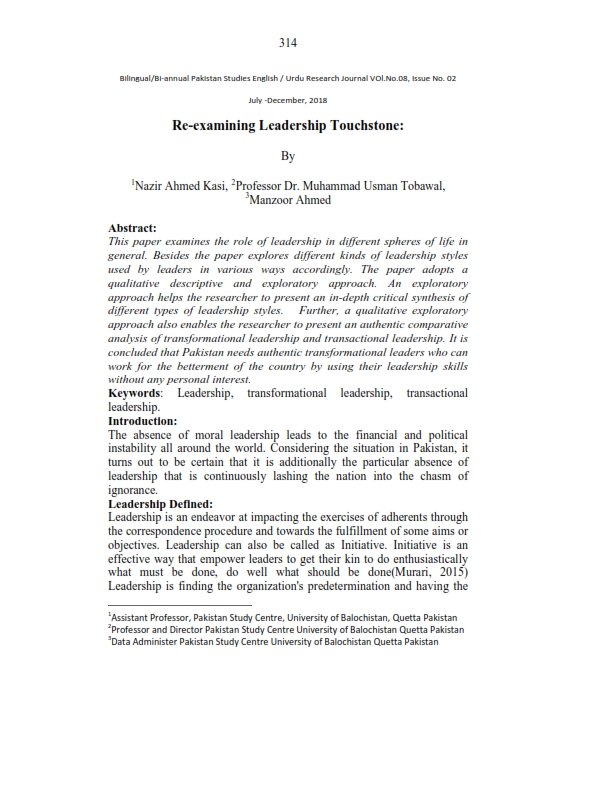Re-examining Leadership Touchstone
Keywords:
Leadership, transformational leadership, transactional leadership.Abstract
This paper examines the role of leadership in different spheres of life in
general. Besides the paper explores different kinds of leadership styles
used by leaders in various ways accordingly. The paper adopts a
qualitative descriptive and exploratory approach. An exploratory
approach helps the researcher to present an in-depth critical synthesis of
different types of leadership styles. Further, a qualitative exploratory
approach also enables the researcher to present an authentic comparative
analysis of transformational leadership and transactional leadership. It is
concluded that Pakistan needs authentic transformational leaders who can
work for the betterment of the country by using their leadership skills
without any personal interest.
References
Cohen, W. A. (1990). The art of the leader. Prentice Hall Press.
Cummings, G. G., MacGregor, T., Davey, M., Lee, H., Wong, C. A., Lo,
E., ... & Stafford, E. (2010). Leadership styles and outcome
patterns for the nursing workforce and work environment: a
systematic review. International journal of nursing studies, 47(3),
-385.
Den Hartog, D. N., House, R. J., Hanges, P. J., Ruiz-Quintanilla, S. A.,
Dorfman, P. W., Abdalla, I. A., ... & Akande, B. E. (1999). Culture
specific and cross-culturally generalizable implicit leadership
theories: Are attributes of charismatic/transformational leadership
universally endorsed? 11The first five authors participated in the
statistical analyses and the writing of this monograph. The Senior
Research Associates provided general research support to the
Principal Investigator and the GLOBE Coordinating Team,
assisted country representatives in translation and back-translations
of instruments and in data collection, and .... The Leadership
Quarterly, 10(2), 219-256.
Drath, W. H., & Palus, C. J. (1994). Making common sense: Leadership as
meaning-making in a community of practice. Center for Creative
Leadership.
Graeff, C. L. (1997). Evolution of situational leadership theory: A critical
review. The Leadership Quarterly, 8(2), 153-170.
Hemphill, J. K., & Coons, A. E. (1957). Development of the leader
behavior description questionnaire. Leader behavior: Its
description and measurement, 6(38).
https://www.dawn.com/news/784355#comments.
Jacobs, T. O., & Jaques, E. (1990). Military executive leadership.
Routledge.
Kearns, M., Suri, S., & Montfort, N. (2006). An experimental study of the
coloring problem on human subject networks. Science, 313(5788),
-827.
Kouzes, J., & Posner, B. Z. (1995). The Leadership Challenge, San
Francisco, California: Jossy-Bass. Liden, RC, Wayne, SJ, Zhao, H.
and Henderson, D. (2008) Servant Leadership: Development of a
multinational measure and multi-level assessment. Leadership
Quarterly, 12(2), 161-177.
Lussier, R. N., & Achua, C. F. (2004). Leadership: Theory. Application,
Skill Development, 2.
Muhammad Burdbar khan (February 07, 2013). Leadership criteria. Dawn
Newspaper.
Murari, K. (2015). Impact of leadership styles on employee empowerment.
Partridge Publishing.
Northouse, P. G. (2015). Leadership: Theory and practice. Sage
publications.
Peters, T. J. (2005). Tom Peters Essentials Leadership. Dorling Kindersly.
Podsakoff, P. M., MacKenzie, S. B., Moorman, R. H., & Fetter, R. (1990).
Transformational leader behaviors and their effects on followers'
trust in leader, satisfaction, and organizational citizenship
behaviors. The leadership quarterly, 1(2), 107-142.
Rauch, C. F., & Behling, O. (1984). Functionalism: Basis for an alternate
approach to the study of leadership. Leaders and managers:
International perspectives on managerial behavior and leadership,
-62.
Richards, D., Engle, S., & Adams, J. D. (1986). Transforming leadership.
Routledge.
Roth, G. L., & Senge, P. M. (1996). From theory to practice: research
territory, processes and structure at an organizational learning
centre. Journal of Organizational Change Management, 9(1), 92-
Schein, E. H. (2010). Organizational culture and leadership (Vol. 2). John
Wiley & Sons.
Seemiller, C., & Murray, T. (2013). The common language of
leadership. Journal of Leadership Studies, 7(1), 33-45.
Shani, A. B., Mohrman, S. A., Pasmore, W. A., Stymne, B., & Adler, N.
(Eds.). (2007). Handbook of collaborative management research.
Sage Publications.
Tangkudung, Yulita. (2015). "Analyzing the effect of leadership style and
job environment towards employee turnover intention (A case
study: PT. Meares soputan mining.
Tannenbaum. R., Weschler, I., & Massarik, F. (2013). Leadership and
organization. Routledge.
Wallace Jr, R. C., Engel, D. E., & Mooney, J. E. (1997). The Learning
School: A Guide to Vision-Based Leadership. Corwin Press, Inc.,
Teller Road, Thousand Oaks, CA 91320-2218 (Hardcover:
ISBN-0-8039-6508-0, $51.95; Softcover: ISBN-0-8039-6409-9,
$23.95).
Zaccaro, S. J., Kemp, C., & Bader, P. (2004). Leader traits and
attributes. The nature of leadership, 101, 124.



